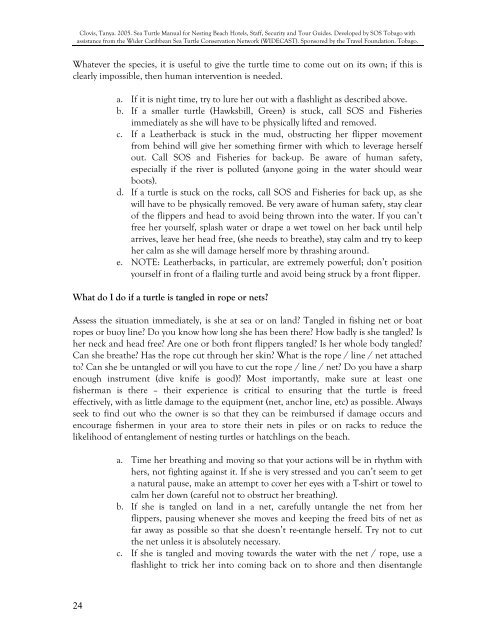Clovis, Tanya. - WIDECAST
Clovis, Tanya. - WIDECAST
Clovis, Tanya. - WIDECAST
Create successful ePaper yourself
Turn your PDF publications into a flip-book with our unique Google optimized e-Paper software.
<strong>Clovis</strong>, <strong>Tanya</strong>. 2005. Sea Turtle Manual for Nesting Beach Hotels, Staff, Security and Tour Guides. Developed by SOS Tobago with<br />
assistance from the Wider Caribbean Sea Turtle Conservation Network (<strong>WIDECAST</strong>). Sponsored by the Travel Foundation. Tobago.<br />
Whatever the species, it is useful to give the turtle time to come out on its own; if this is<br />
clearly impossible, then human intervention is needed.<br />
a. If it is night time, try to lure her out with a flashlight as described above.<br />
b. If a smaller turtle (Hawksbill, Green) is stuck, call SOS and Fisheries<br />
immediately as she will have to be physically lifted and removed.<br />
c. If a Leatherback is stuck in the mud, obstructing her flipper movement<br />
from behind will give her something firmer with which to leverage herself<br />
out. Call SOS and Fisheries for back-up. Be aware of human safety,<br />
especially if the river is polluted (anyone going in the water should wear<br />
boots).<br />
d. If a turtle is stuck on the rocks, call SOS and Fisheries for back up, as she<br />
will have to be physically removed. Be very aware of human safety, stay clear<br />
of the flippers and head to avoid being thrown into the water. If you can’t<br />
free her yourself, splash water or drape a wet towel on her back until help<br />
arrives, leave her head free, (she needs to breathe), stay calm and try to keep<br />
her calm as she will damage herself more by thrashing around.<br />
e. NOTE: Leatherbacks, in particular, are extremely powerful; don’t position<br />
yourself in front of a flailing turtle and avoid being struck by a front flipper.<br />
What do I do if a turtle is tangled in rope or nets<br />
Assess the situation immediately, is she at sea or on land Tangled in fishing net or boat<br />
ropes or buoy line Do you know how long she has been there How badly is she tangled Is<br />
her neck and head free Are one or both front flippers tangled Is her whole body tangled<br />
Can she breathe Has the rope cut through her skin What is the rope / line / net attached<br />
to Can she be untangled or will you have to cut the rope / line / net Do you have a sharp<br />
enough instrument (dive knife is good) Most importantly, make sure at least one<br />
fisherman is there – their experience is critical to ensuring that the turtle is freed<br />
effectively, with as little damage to the equipment (net, anchor line, etc) as possible. Always<br />
seek to find out who the owner is so that they can be reimbursed if damage occurs and<br />
encourage fishermen in your area to store their nets in piles or on racks to reduce the<br />
likelihood of entanglement of nesting turtles or hatchlings on the beach.<br />
a. Time her breathing and moving so that your actions will be in rhythm with<br />
hers, not fighting against it. If she is very stressed and you can’t seem to get<br />
a natural pause, make an attempt to cover her eyes with a T-shirt or towel to<br />
calm her down (careful not to obstruct her breathing).<br />
b. If she is tangled on land in a net, carefully untangle the net from her<br />
flippers, pausing whenever she moves and keeping the freed bits of net as<br />
far away as possible so that she doesn’t re-entangle herself. Try not to cut<br />
the net unless it is absolutely necessary.<br />
c. If she is tangled and moving towards the water with the net / rope, use a<br />
flashlight to trick her into coming back on to shore and then disentangle<br />
24
















